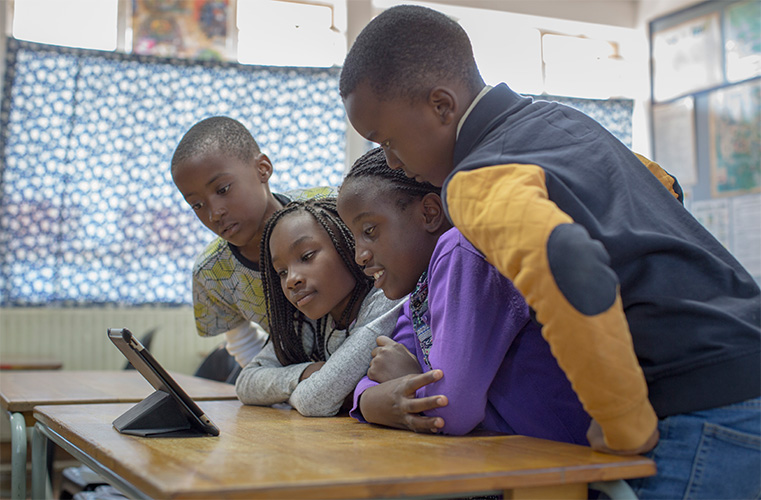By Wayne Thembani Chinembiri, LL.M and Dr. Claudia Tapia, LL.M
Education is a fundamental human right embodied in Article 26 of the Universal Declaration on Human Rights (UDHR). Still, UNESCO reports that more than 262 million children and youth lack access to education and that “750 million adults are illiterate, fueling poverty and marginalization.” At its peak, school closures due to the Covid-19 pandemic affected approximately 1.6 billion learners. Statistics show that Sub-Saharan Africa is especially affected since it has the highest rates of exclusion from education to date. For that reason, it is necessary to implement new strategies and technology-driven solutions. A tested starting point is that of remote learning, which is greatly enabled by the adoption of cellular standards.
Remote learning means teaching that takes place in circumstances where the learner and the teacher, or source of teaching material, are physically separated. An example of remote learning is online education platforms which can reach remote areas via mobile telecommunication offered by cellular standards.
By implementing cellular standards, several projects are already delivering quality educational material to millions of children around the world. This process typically starts with a ‘mapping’, i.e., a process of identifying in a map of a region (e.g. a country) the locations of schools where there are connectivity gaps and those where connectivity is provided. This mapping allows countries to assess their existing infrastructure and to come up with appropriate solutions for connecting their schools.
This mapping process led Kazakhstan to connect almost all of its schools (only 11 are yet to be connected) to the Internet utilizing cellular standards. The government of Kyrgyzstan also did a mapping for all 2,180 public schools to, later on, connect the remaining 690 public schools.
Remote learning is particularly relevant in Africa because children can continue to learn from the safety of their homes and access a wider variety of higher-quality educational material. Online learning means that potential school closures, e.g. due to Covid-19 pandemic lockdowns, would no longer have a devastating impact on African children’s access to education. But even after the pandemic, remote learning is a ‘must-have to spread education around Africa, in particular for remote areas.
In Africa, countries like Rwanda, Kenya, Sierra Leone, and Uganda are actively working with UNICEF and partners like Ericsson, Boston Consulting Group, and SoftBank Group in the GIGA project to connect all schools. Following the mapping results, the GIGA partners “advise on the best possible technical solutions to provide schools with connectivity, and countries with safe, secure, reliable, fit-for-purpose infrastructure to support future digital development needs.” Another example is UNESCO’s e-schools Initiative, which educates countries, amongst other things, on how information and communication technology (ICT) facilitates universal access to education, and bridges learning divides. The initiative also assists countries by providing guidelines on successful ICT in education practices and how to leverage technology for learning.
Current and upcoming challenges in terms of education highlight the importance of connectivity provided by cellular standards such as 2G to 5G. Cellular standards exist thanks to massive investments in research and development (R&D) and result from collaborative efforts between different stakeholders, including governments, research institutions, and companies. Ericsson, for instance, is one of the leading companies in cellular standardization, having made approximately 70,000 contributions since 1999 to develop 2G to 5G. In 2021, the company reinvested 18% of its previous year’s sales revenues in R&D. This is an impressive commitment, in particular when compared to other large companies. For instance, in 2020 Apple reinvested 7%, Amazon 11.1%, and Microsoft 13% of their 2019 sales revenue to R&D.
Considering the large expenditures on R&D, it is not surprising that cutting-edge cellular technologies are generally protected by patents. A patent is a set of exclusive rights for an invention that is new (i.e., not known), offers an inventive step (i.e., is not obvious to a person skilled in the art), and is industrially applicable (i.e. it can be made or used in some kind of industry).
While patents confer the right to ‘exclude’ others from their use, in the context of cellular standards, access is provided from the very first day. Patented inventions that are necessary to comply with a technical standard—Standard Essential Patents or SEPs—are typically made available on Fair, Reasonable and Non-Discriminatory (F/RAND) terms and conditions. F/RAND balances the interests of innovators and implementers: SEP holders are adequately and fairly rewarded, while standards are made available to (future) users, preventing a waste of resources from both sides. Injunctions forbidding implementers to make, use or sell goods or services that infringe patented standardized technologies, are granted only when SEP users behave in bad faith (as “unwilling licensees”). This particularly applies when SEP users do not ‘clearly’ and ‘unambiguously’ declare their willingness to conclude a F/RAND agreement or do not engage in licensing negotiations in a ‘target-oriented’ manner.
As cellular standards are often protected by patents accessible on reasonable royalties, Africa must guarantee a functioning and strong patent system. Weak patent protection in Africa may lead to suboptimal investment in infrastructure and technological development. On the other hand, if patented technologies are appropriately protected, inventors can capture part of the socio-economic value of their discoveries, fostering reinvestment in R&D (as the example of Ericsson has shown).
By supporting F/RAND compensation for the use of cellular standards, Africa can become ‘smart(er)’ and promote the hybridization of the education ecosystem.
Disclaimer: Wayne Thembani Chinembiri, LL.M is a Legal Researcher, and Dr. Claudia Tapia, LL.M is the Director of IP Policy and Legal Academic Research, both at Ericsson. The views expressed in this article are the authors’ alone and do not necessarily represent those of Ericsson.

